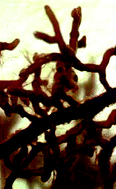Isolation of naturally occurring aluminium ligands using immobilized metal affinity chromatography for analysis by ESI-MS
Abstract
Aluminium (III) is one of the most abundant metal ions found in soil. Typically, Al+3 is bound to minerals, but its bioavailability and toxicity toward vascular plants increases with increasing soil acidity. Ectomycorrhizal fungi, which live symbiotically on the roots of numerous woody plants, often confer Al+3 resistance to host plants by reducing metal availability to the plant by unknown mechanisms. A potential mechanism of detoxification is binding of the Al+3 by organic compounds that are exuded by the fungi into the surrounding soil and solution. A novel method has been developed to purify and characterize Al+3 binding ligands from Pisolithus tinctorius exudate solutions using Al+3 immobilized metal affinity chromatography (IMAC), reversed phase chromatography, and mass spectrometry. Fungal exudates produced by P. tinctorius exhibit a strong binding capacity for Al+3, allowing their selective enrichment and collection using this IMAC method. Elution of the ligands requires the use of high pH. RP-HPLC separation and elemental analysis of the IMAC elutent indicates that the Al+3 and the exudate ligands both elute from the column but are not bound in a complex. Thus, reversed phase HPLC at pH 10 is used for separation of the ligands and Al+3 prior to MS analysis. The strongest binding IMAC fraction is analyzed by electrospray ionization mass spectrometry in positive and negative ion modes. This report provides new methods for the direct purification and analysis of naturally occurring ligands that bind hard metal ions.


 Please wait while we load your content...
Please wait while we load your content...